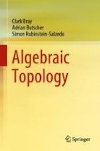- About MAA
- Membership
- MAA Publications
- Periodicals
- Blogs
- MAA Book Series
- MAA Press (an imprint of the AMS)
- MAA Notes
- MAA Reviews
- Mathematical Communication
- Information for Libraries
- Author Resources
- Advertise with MAA
- Meetings
- Competitions
- Programs
- Communities
- MAA Sections
- SIGMAA
- MAA Connect
- Students
- MAA Awards
- Awards Booklets
- Writing Awards
- Teaching Awards
- Service Awards
- Research Awards
- Lecture Awards
- Putnam Competition Individual and Team Winners
- D. E. Shaw Group AMC 8 Awards & Certificates
- Maryam Mirzakhani AMC 10 A Awards & Certificates
- Two Sigma AMC 10 B Awards & Certificates
- Jane Street AMC 12 A Awards & Certificates
- Akamai AMC 12 B Awards & Certificates
- High School Teachers
- News
You are here
Algebraic Topology

Publisher:
Springer
Publication Date:
2021
Number of Pages:
223
Format:
Paperback
Price:
49.99
ISBN:
978-3030706074
Category:
Textbook
The Basic Library List Committee suggests that undergraduate mathematics libraries consider this book for acquisition.
[Reviewed by , on ]
Michele Intermont
07/3/2022
There are several books aimed at undergraduate topology, including some focused on algebraic topology. For example, Algebraic Topology, An Intuitive Approach by Sato, and Topology Through Inquiry by Starbird and Su have been reviewed here. Does this book add to the literature? Yes, it does.
Bray, Butscher, and Rubinstein-Salzedo’s volume Algebraic Topology is an outgrowth of a long-standing summer program at Stanford University for high-achieving high school students. As such, the authors assume only that their readers are interested and motivated, and the necessary algebra and point-set topology are included as the book proceeds. They work diligently to keep readers engaged with their informal tone and by being willing to veer off to share related but tangential ideas.
The text starts with the topic of surfaces, quickly introducing the topological definition of continuous function. A discussion of Euler characteristic follows, allowing for the introduction of abstract topological spaces and quotient spaces. After classifying compact surfaces, algebra enters the picture. The chapter which introduces group theory starts with the question “Why use groups?” and finishes with sections on free groups and free products of groups. There are several more chapters focusing on group theory before introducing the fundamental group. The fundamental group is, as one would expect, given a prominent place in the text. This includes a chapter devoted to the Seifert-van Kampen theorem (and its proof), with mention of the realizability of any group as the fundamental group of a space. That’s a lot to accomplish! The final two chapters of the book turn to homology theory and the Mayer-Vietoris sequence. There are exercises at the end of each chapter, and some more are scattered throughout some of the chapters.
While the original audience for this book was high school students, make no mistake that the book is nicely aimed at undergraduates. If students have already studied group theory, those chapters could be omitted, and there is still enough material for a semester course. So how does this book add to the literature? Quite nicely. To compare with the texts mentioned above, the focus of Sato’s book is on the homology and cohomology of cell complexes. Starbird and Su’s book is an encyclopedia compared to these other two – developing point-set topology as well as introducing manifolds and simplicial complexes, classifying compact surfaces, and expositing on the topics of the fundamental group, homology, covering spaces, etc. All three are readable, with less sophistication necessary for Bray, Butscher, Rubinstein-Salzedo’s text than the others.
Michele Intermont is an Associate Professor of Mathematics at Kalamazoo College. Her interests are in the field of topology.
See the publisher's website.
- Log in to post comments




